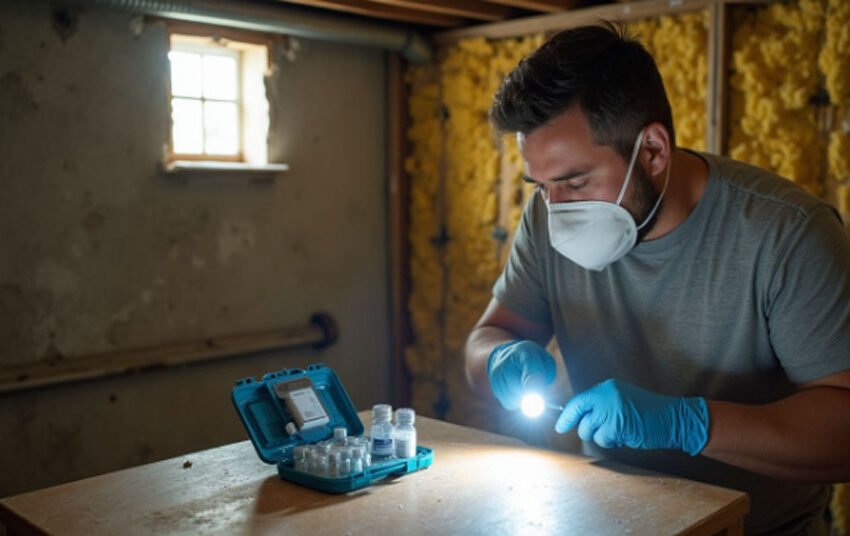Waterproofing Your Basement? Don’t Skip the Asbestos Testing First

Are you planning to waterproof your basement but worry about hidden health risks? Many older homes may have asbestos in the walls, floors, or pipes. This guide will show you why testing for asbestos is key before any home improvement or renovation.
Read on to keep your family safe and your project on track.
Why Asbestos Testing is Crucial Before Waterproofing
Asbestos can be present in many old basements without any warning signs. Testing before using a professional service for basement waterproofing in Scranton keeps you safe from health risks and costly surprises.
Hidden dangers of asbestos in older homes
Homes built before the 1980s often contain asbestos in building materials like insulation, pipe wrapping, and old floor tiles. Cutting, drilling, or removing these items during basement waterproofing can release harmful fibers into the air. Even a small disturbance may cause asbestos exposure.
Asbestos fibers are tiny and nearly invisible. They can linger in dust for days or weeks. People who live or work in these homes might not notice any immediate issues, but breathing in these fibers raises long-term health risks, according to Propertycare Property Management.
Proper environmental testing and asbestos testing help find hidden hazards before starting home renovation projects such as basement waterproofing or mold prevention.
Health risks associated with asbestos exposure
Breathing in asbestos fibers can cause serious lung problems. Asbestos exposure leads to diseases like asbestosis, lung cancer, and mesothelioma. The U.S. Environmental Protection Agency (EPA) and the Centers for Disease Control and Prevention (CDC) warn that even a small amount of asbestos can damage your health over time. Children are more at risk because their lungs are still developing.
People who disturb old insulation or pipe coverings during basement waterproofing work may release hidden asbestos particles into the air. These tiny fibers get stuck in the lungs; years later, they can make people very sick or even lead to death.
Common Areas Where Asbestos May Be Found in Basements
Asbestos can hide in many materials used during old basement construction and repairs. You may find it in places you would not expect if you do not check carefully before starting any work.
Insulation materials
Insulation materials in many older homes often contain asbestos. Builders used asbestos because it resisted heat, fire, and water damage. You can find this type of hazardous material wrapped around pipes, wires, or even walls in basements built before the 1980s. Cutting or moving these materials during basement waterproofing can release dangerous fibers into the air.
Breathing in asbestos dust puts your health at risk. It causes serious diseases like lung cancer and mesothelioma. Environmental testing helps spot these risks before any home renovation begins. Take action to protect your family by handling insulation safely if you plan on basement improvement projects such as waterproofing or mold prevention.
Flooring and adhesives
Floor tiles and adhesives in many older homes contain asbestos. Many basements built before the 1980s used vinyl floor tiles or linoleum with asbestos to add strength and resist water. The glue under these floors, called mastic, often contains hidden asbestos fibers, too. Cutting, sanding, or removing old flooring for basement waterproofing can send toxic dust into the air. This exposes workers and families to serious health risks like lung disease.
Basement waterproofing often means pulling up old tiles or scraping off glue during home renovation projects. Testing for asbestos first helps you avoid accidental exposure and keeps your family safe. Always rely on an asbestos testing service. The professionals know how to spot hazardous materials in flooring and adhesives before starting any construction work on your basement floors.
Pipe and duct coverings
Pipe and duct coverings in older basements often contain asbestos. Builders used asbestos materials until the 1980s to wrap pipes and ducts because they resisted heat, fire, and water.
These coverings can look like white or gray cloth, cardboard-like jackets, or hard plaster. Even small cracks or damage in these wrappings can send hazardous fibers into the air during basement waterproofing.
Disturbed pipe insulation is one of the most common ways people face asbestos exposure in home renovation projects. Touching or moving these pipes without proper environmental testing may put your health at risk. Many states require special inspection before any work begins if a home was built before 1990.
Asbestos-containing pipe insulation is still found in millions of American homes, says the Environmental Protection Agency (EPA). Even minor repairs can disturb it. Safe construction practices start with professional asbestos testing before you seal leaks or add mold prevention systems. This step protects both your home value and your family’s safety from dangerous airborne particles.
Steps to Take Before Waterproofing
Start with a full check for asbestos before any basement waterproofing. Get expert help to make sure your home stays safe during the renovation.
Hire a professional asbestos inspector
Hire a professional asbestos inspector before starting any basement waterproofing. Inspectors use special tools and training to find hidden hazardous materials like asbestos. This step protects your family from serious health risks such as lung disease, which can occur if asbestos fibers get into the air during home renovation or when handling construction debris.
Only licensed professionals should handle environmental testing for asbestos in basements. They know where to look, including insulation, old flooring, pipe wraps, and adhesives often found in homes built before 1980. Their inspection helps you avoid extra costs or legal issues later by making sure all hazards are identified early.
Conduct comprehensive asbestos testing
After a licensed inspector checks your basement, start with full asbestos testing before any basement waterproofing. Test all possible spots where hazardous materials may be present, such as old insulation, vinyl flooring, pipe wrap, and ceiling tiles.
Environmental testing finds hidden risks that could harm your health during home renovation. Only trained experts can safely collect samples for lab tests. This step ensures no asbestos fibers will spread during construction or water damage repairs.
Accurate results support safer home improvement and protect property value from future legal or health issues linked to asbestos exposure.
What to Do If Asbestos is Found
If you find asbestos, stop work right away and stay out of the area. Call a licensed removal expert to handle the material safely.
Safe removal by licensed professionals
Licensed asbestos removal experts use special tools and safety gear. They seal off the area to stop dust from spreading during basement waterproofing or home renovation. These professionals follow strict rules set by groups like OSHA and the EPA. Safe disposal of hazardous materials keeps your family, pets, and property safe.
Trying to remove asbestos without training is risky. Even tiny fibers can cause health problems such as lung cancer if inhaled. Experts know how to bag and label all waste for approved landfills.
Proper handling of asbestos protects both workers and homeowners from life-threatening exposure, says the Environmental Protection Agency. Using licensed pros helps keep construction safety high while protecting property value and reducing future health risks.
Following proper disposal procedures
Asbestos debris and waste must go in special sealed bags. Workers wear protective gear during cleanup to avoid health risks from asbestos exposure. After sealing the waste, trained crews label it as a hazardous material. They transport it directly to approved landfills that can handle asbestos safely.
Basement waterproofing projects require strict adherence to construction safety rules regarding hazardous materials like asbestos. The Environmental Protection Agency (EPA) sets clear guidelines for asbestos disposal in home renovation jobs. Ignoring these procedures risks fines, property value loss, or harm to people handling the waste.
Benefits of Addressing Asbestos Before Waterproofing
You set up your home for safer living when you deal with asbestos first. You also protect your family from future risks and trouble.
Ensuring a healthier home environment
Asbestos testing before basement waterproofing helps protect your family from health risks. Asbestos fibers can cause breathing problems and even cancer if disturbed during home renovation.
By removing hazardous materials like asbestos first, the risk of exposure drops sharply. This step also keeps mold and other pollutants from spreading when sealing or working on damp areas.
Professional environmental testing ensures hidden threats are found in insulation, old flooring, or pipe coverings. A clean and safe basement stops harmful particles from moving through your house’s air supply. Addressing these issues early supports better indoor air quality for everyone living in the home.
Preventing costly legal or health issues later
A healthy home can also save you from future problems. Skipping asbestos testing during basement waterproofing can lead to expensive lawsuits or health claims. Homeowners could face fines if they disturb hazardous materials like asbestos without following state or EPA rules. In the United States, proper environmental testing is a legal requirement in many states before starting home renovation projects.
Exposure to asbestos fibers causes lung cancer and other serious diseases. If someone becomes sick due to missed or ignored asbestos risks, costly medical bills and lawsuits may follow years later. Proper risk assessment now lowers these dangers and protects both your family and your property value for years to come.
Conclusion
Testing for asbestos protects your family’s health before basement waterproofing. This simple step can prevent serious problems in the future. Hiring experts keeps your home safer and increases its value.
Always check for hazardous materials before starting any renovation job. Safe choices keep your space dry and healthy for years to come.





